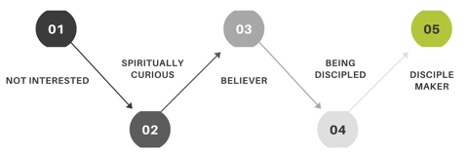8 Questions to Ask about Outreach and Technology
Developing an effective digital ministry strategy takes careful planning, but the rewards are worth it, especially as unchurched or de-churched people begin to engage with Jesus. Here’s how technology can help you grow your church and improve your community outreach. | by Tiffany Deluccia
Our churches are losing the content battle.
The Unstuck Group has worked with churches of all shapes and sizes for the past 11 years, and what’s one thing we almost never see a church doing well? Even the big ones?
Content strategy.
Even before the coronavirus hit, we were living through the biggest communication shift in 500 years. Fewer people were attending church and more were utilizing the web for every aspect of their lives, and most church communications are outdated.
Now that COVID-19 has vastly accelerated all of those trends that we were seeing beforehand, our churches can’t afford not to have a digital content strategy. This isn’t something we can just add on the side — it’s a full scale shift.
Searching people are finding answers from everyone but the local church.
We don’t doubt that your student ministry or small groups are answering some of life’s toughest questions, but do you answer them online in a way that an unchurched person might find them?
What if seeking out ways to connect online is now the first step to inviting people into community? How would that change your approach to the content you are planning and producing? How can you equip your current congregation to leverage their social networks for inviting people into conversations about God and into community with your church?
In late September 2020, The Unstuck Group conducted a survey to learn more about how churches are engaging digital ministry strategies. Many of the results were disheartening, but this one in particular stood out…
Only 21% of those surveyed agreed with this statement: “We have a well-defined digital ministry strategy to engage with people who are outside the church and outside the faith.” In other words, 79% don’t.
It’s time to shift away from defining your digital ministry strategies as putting your services online and to start thinking about how to really connect with people outside the church and outside the faith.
Where To Begin
Thousands of churches are getting serious about developing a real digital ministry strategy. The Unstuck Group heard from pastors across the country, and they consistently asked the same question:
“What would YOU do if you worked at our church?”
But the answer to this question is not that easy. This is the reality:
It is complicated.
Ultimately, your digital ministry strategy cannot be an addition to your “real” ministry methods. You have to dig all the way down to the foundation of your ministry and then start answering these key questions:
- What’s your vision for the next 5 years?
(What do you believe God wants your church to look like?)
- Who are you trying to reach?
(Who has God equipped you to serve really, really well?)
- How are you reaching them now?
(What’s already working for you? What’s driving growth?)
- If you’re losing people, why are they leaving?
(What are they choosing instead?)
- Who is your competition?
(HINT: It’s probably not other churches. How is culture attempting to meet the needs only God and the local church can truly meet?)
- How are you perceived in your community?
(Is the perception true? Do you need to change it?)
- What are your goals for trying a new strategy?
(How will you know you’re winning?)
- Who does what on your team?
(Who owns and drives each goal?)
If those sound more “big picture” than specifically related to communications strategy, it’s because they are.
No digital strategy company worth its hefty retainer would tell you they can give you a strategy that will work without diving deep into understanding who you are, where you’re going, and how you define success.
Digital Ministry Strategy = Ministry Strategy
Digital strategies are going to become embedded parts of your ministry strategy. It won’t be something separate. It won’t be something different.
They will be elemental, essential, components of how you do what you do to help people far from God meet him and take next steps in their relationship with him.
That new, clear perspective you have on how your church does ministry will include in-person gatherings and environments and online gatherings and environments — with both in-person next steps and digital ones.
And they’ll all be completely woven together, into one comprehensive way you do church.
And you’ll revisit, and change it, and try new things, and keep iterating with the things you learn — because it won’t be your digital ministry strategy. It will just be your ministry strategy.
Who Are You Trying To Reach?
If a church does not define this, the planning process is very difficult because everyone is confused about who they are designing ministry for.
The temptation is to answer, “Everyone!” Why wouldn’t we want everyone to know about Jesus? That’s ultimately why we got into ministry, right?
But the problem is, churches THINK we’re speaking to everyone, but we’re not. We’re usually talking to people just like us in big, vague terms that don’t connect on a personal level.
It’s crucial to have a defined mission field to lead a growing church. You can’t have an effective ministry strategy without knowing who you are trying to reach. And you certainly can’t expand your church’s digital front door if you don’t know who you are trying to reach.
With that said, there are a few key identifiers to dig into:
- Age Range
Ideally this is a 10-year range but no more than 15 years.
- Spiritual Condition
Unchurched, De-churched, Spiritually Curious, Disciple-Maker, etc.?
*This visual is how we define the stages of a person’s spiritual journey:

and…
- Life Stage
Single, Married, Parents, Empty Nesters, Retirees, etc.?
From there, we want to learn more about our mission field, their needs and what they value. How can you address their needs based on where they are in life?
This is not about exclusion; this is about focus.
The more clarity churches have about who they are trying to reach the more likely the church is to reach a broad cross-section of their community.
What + Where + When
Once you’ve defined big picture strategy, you’re faced with the next challenge:
How do we actually get them to engage?
Our world is noisy, and our markets are saturated with too much content. How do we get our content in front of the people we’re trying to reach?
There are a few key components as you build your digital engagement strategy that will ultimately help you get your audience to engage.
- Clarify the engagement goal for each step along a person’s spiritual journey.
Before you build a strategy, you need to define the goal. What is the ultimate win for them in this phase?
As an example, the goal for someone who is Not Interested may be simply to introduce the church to these new folks. For someone on the opposite end of the continuum, a Disciple Maker, the engagement goal might be to build relationships with people outside the faith.
You have to define these goals, so you ultimately engage the right people with the right content.
- Determine your content strategy (primary message) for each step on the continuum.
For someone who is Not Interested, for example, our strong encouragement is that you build your content strategy around providing help and answers for living life, addressing the opportunities, and challenges they are facing in their daily lives, like relationships, parenting, emotional/mental health, purpose, financial health, etc.
To do so necessitates that before you build your content strategy, you clearly identify who you are trying to reach and what their needs are (opportunities and challenges).
- Determine how you are going to deliver that content (the primary medium) for each step on the continuum.
It’s not just about creating the right content, it’s also about engaging people where they are online, rather than where we want them to be.
For people who are Not Interested, we want them to be in church. That’s not where they are today. That means we have to provide this practical content on the platforms where they are living life and using the media that they are engaging. We need to speak their language in their environments.
- Think digital content, rather than online services.
- Think shareable online, rather than a requirement to show up in-person.
- Think Facebook, Instagram, and YouTube, rather than your sanctuary or a church classroom.
What To Measure
So, we’re online… but how do we figure out what to measure when we’re doing ministry online? How do we know if what we’re seeing is good? Or if it’s even strong engagement?
Our take on metrics is that everything you measure should help you make better decisions and refine your strategies for reaching people and helping them take next steps in their faith journey.
At a bare minimum, your team needs to be monitoring some of these things so they can help you decide which things are working to help people take their first steps and next steps. Consider the following questions:
Are we reaching new people? (e.g., new vs. returning visitors to your website, new followers on social media, etc.)
How many people are taking their first steps? (e.g., first time they give you their email address or mobile number, etc.)
How did they take that first step? (e.g., specific content series, form to join a group, new app account created, etc.)
With digital strategies (and particularly social strategies), it’s always about testing and measuring and more testing. However, we recommend not test-driving anything new until you know you can measure whether it helped someone take a first step or a next step first. And from there, you’re…
- Testing
- Measuring
- Revising/rethinking
- Testing again
Examples From Real Churches Using Digital Ministry Strategies
If you ask 10 pastors to define “digital engagement,” you’re likely to get 10 different answers. The interpretation can seem vague, confusing, and sometimes just impractical.
And while few churches are very far along in developing an effective strategy, there are some who are already out in front, leading the way, and finding best practices.
Some of those best practices and stories come from real churches who are implementing a digital engagement strategy.
- Grace Church (Massachusetts) — Started hosting Webinar Wednesdays on topics, like overcoming fear and anxiety, talking to kids about racism, starting a thriving business, and keeping your kids safe online.
- Westside Community Church (Oregon) — Launched a new podcast…only it’s not your typical church podcast with a replay of the Sunday message. Lead pastor Gabe Kolstad and his wife have started a podcast called Marriage Monthly to help marriages that are under pressure in this season, and ultimately help the church connect with new people.
- Sun Valley Community Church (Arizona) — Hosted a digital marriage retreat. More than 900 couples participated, and one third of them were brand new people.
This article originally appeared on the Unstuck Group website. Used by permission.






